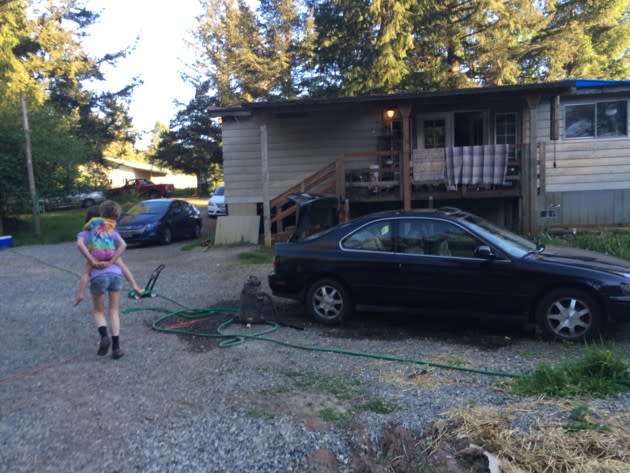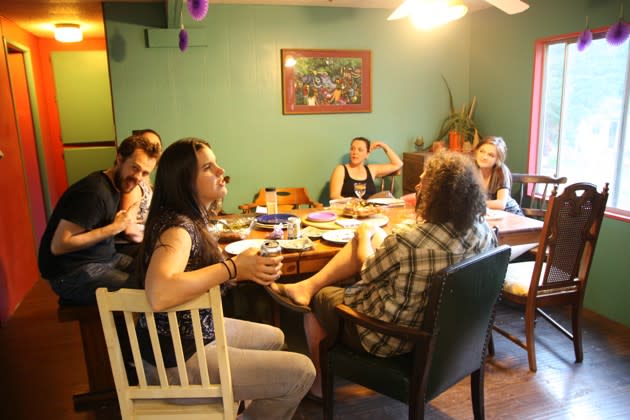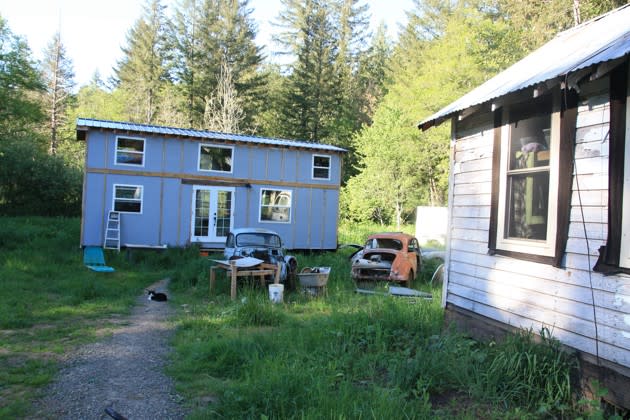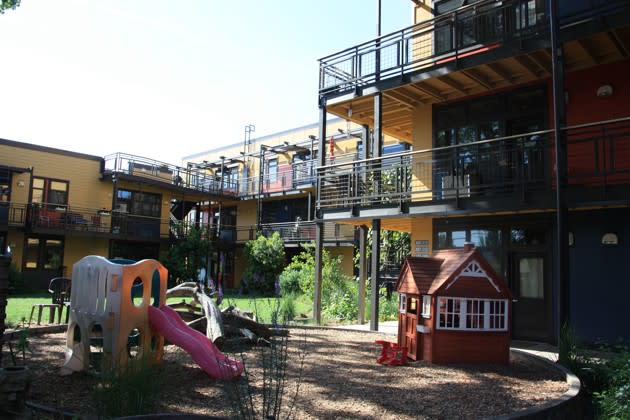Eight Parents, One Shower
COLTON, Oregon—On 20 acres of land outside Portland, eight adults are rethinking what many Americans would consider a normal family structure. They’re trying to address many of the burdens that come with modern life, including the hours taken up by full-time jobs and the challenges of raising children in a nuclear family.
The four couples—two with young children, two with teenagers—share the property, a rambling plot of land with meadows, forests, a brook and an assortment of old rusted-out cars and trailers leftover from the previous property owner. There’s a main house and two small cabins out back; One of the only rules for the community is that everybody will share the main house’s two bathrooms, one shower and the kitchen.
It’s an experiment in community living in which the families help raise each other’s children, pool resources for rent and food, share skills and knowledge, and keep each other sane. The idea is for the adults to share their lives with their best friends, at the same time creating a large extended family for their kids.
Recommended: Why Losing China Will Probably Be Good for Uber
“We try to be the village that people talk about when it comes to the kids - not that it always works,” one of the mothers of young children, Gracey Nagle, told me. Nagle and a few members of the group have been living in a shared house since 2003. When the home’s owner decided to stop renting it, they searched around for another place and found the Colton property. Some of the original members have moved on since the early days, but others have stayed and brought spouses and partners and children into the fold.

I visited on an evening in early summer, and the community was a cacophony of adult conversation and screaming children. A teenager and a few adults decorated cupcakes in the kitchen of the small house where community life is centered, while two toddlers played in back. A young child checked on chickens in the coop while a father of her friend carved wood in his shop.
“People going the nuclear family route definitely don’t have the same quality of life.”
Nagle and her partner, Chris Martell, and their two children, ages seven and four, live in one small bedroom in the main house, which also holds a piano. Appeya Galindo and her fiancée Adam Murray live in another bedroom; Galindo’s teenage daughter sometimes stays there too. Erin Corzine and her partner Mike Lyman live with their two kids, ages five and two, in a tiny, one-room cabin in back of the house. Andrea Martin and her boyfriend Luke Precourt live in a small cabin, jokingly called the “tiny mansion” out back (it doesn’t have a kitchen or bathroom); they each have teenaged daughters from a previous relationship who sometimes stay over.
The communal living strategy helps overcome some of the problems faced by parents in nuclear families who live isolated in their own homes. Parenting on your own or with a partner is a full-time job; having other people to help out can go a long way. Daycare is expensive. Friends are not. “There’s huge economies of scale when you have more parents around,” said Nagle, a petite woman with glasses and short hair parted in the middle. “Someone can take over for five minutes if you need to do something.”
Recommended: Why Can't Hillary Clinton Stop Lying?
There are concrete financial advantages, too. Each adult pays $400 a month for rent and general upkeep; people buy food when they remember; the group owns a car but no one is quite sure who has the title. The plot of land where they live was only $275,000 because it was littered with junk when they bought it in 2013. It’s another advantage of living an hour outside Portland—large plots of land are not as expensive as they might be in a big city. The group is eventually hoping to build individual tiny homes on the property around a main house, and perhaps invite other friends to join.
Decisions that will impact the group are made by voting, and any issues are discussed at informal house meetings. Each of the adult members, who are in their thirties and forties, say they envision growing old here.
The low expenses allow the adults to take a different approach to working and child-rearing than they might if they just shared a home with their partner and children. “I’ll retire earlier. My lifestyle is different. It’s not that high-stress kind of thing,” Andrea Martin, who has a 17-year-old daughter, told me.

None of the adults feel pressured to have jobs that would pay a whole mortgage. Nagle, a Yale graduate who used to work as a paralegal, recently quit her part-time job and started managing and booking bands with her partner Martell. One of the other adults is in school, another has a small business that makes baby rattles, another is a teacher at a charter school, and another works around town doing odd jobs. Everyone knows that if they have a financial emergency, they can borrow from other community members. They look forward to the day when they pay off the mortgage (it’s in Nagle’s name), and just have to pay for taxes and upkeep. Then, they might not have to work at all. “People going the nuclear family route definitely don’t have the same quality of life,” Martell told me.
Recommended: The Lonely, Thirsty, Final Days of the Doomed Alaskan Mammoths
It’s an atypical arrangement, and one that might raise eyebrows in a place other than rural Oregon. When the adults, friends since childhood, first started to live together, their extended families thought they were crazy. Their parents sometimes still ask when they’re going to grow up and get a house of their own. Most Americans can’t imagine any other way to raise kids.
“When it comes to the well-being of children, Americans engage in nuclear family triumphalism,” the sociologist Bella DePaulo writes in her book, How We Live Now. “They are convinced that children who are raised by two married heterosexual parents are going to be happier, healthier, better educated, less likely to get in trouble, and better off in just about every conceivable way than kids who are brought up any other way.”
Yet a study of children raised in non-nuclear households found that children raised by single, divorced parents in multigenerational households, for example, did just as well as those raised in nuclear families, DePaulo writes. They were no more likely to smoke, drink, or have sex at an early age. They were as likely as children living in nuclear family households to graduate from high school and enroll in college. Children of parents who had never been married and were raised in a multigenerational household did even better.
Andrea Martin says that living with the group is much healthier than living on her own. She moved out a few years ago when she her boyfriend, fellow community member Luke Precourt, broke up temporarily. Martin and her daughter, now 17, lived in their own apartment by themselves for two years. Martin says raising her daughter was much more difficult outside of the community. “If I had to work late, she’d be home by herself watching TV and eating macaroni and cheese, instead of being here with people who love and support her,” Martin told me. She and Precourt since got back together and moved back into the communal home.

Martin’s daughter says she was sometimes embarrassed by the group’s living arrangement when she was in middle school, but told me her friends are now in awe of the community of adults she has around her.“It’s boring living by yourself. So boring,” she told me, in the tiny home in back of the larger house where she lives with her mother and Precourt, which has two sleeping lofts and a living room. “TV is not as fun as hanging out with other people.”
Martin says that the community is the best place for her to raise her daughter. Adults can assist with homework or talk to her about things she might not want to discuss with her mom. An only child, Martin’s daughter has surrogate siblings to spend Christmas morning with in Colton, and strong male figures to look up to.“I know it’s definitely the healthiest environment for her,” Martin said.
There are signs that this sentiment is becoming increasingly popular across the country. Developers are building new co-housing complexes in which people have their own apartments yet form a close-knit community. They’re investing in tiny apartments for Millennials who want to share fancy kitchens and rec rooms with other people like them. At the same time, the number of adults living with a spouse is on the decline, according to Census data. In 1967, 70 percent of adults lived with a spouse; by 2014, only about 50 percent did. The rest live with a partner or with others who aren’t their spouse—like roommates or children.
When in Portland, I also visited a co-housing community called Daybreak, a bright and airy apartment complex with a shared communal space. Single mom Malka Geffen lives there with her four-year-old daughter, and she told me having other families around was a lifesaver. The two attend the weekly group dinners and hang out in the playroom, go to movie nights and share popsicles with the other kids who live in the complex. They’ll go visit the elderly couple upstairs who are surrogate grandparents, or watch the teenagers her daughter idolizes. When Geffen goes out of town with her daughter, neighbors will water her plants and give her rides to the airport, pick up her mail and watch her apartment. “It feels so safe, knowing people are looking out for you,” Geffen told me. “If we were in a single family home, I don’t know if I’d feel as safe.”
It makes sense that people are forming more intentional communities as Americans feel more disjointed from the people around them. As Robert Putnam explained in his seminal book Bowling Alone, there has, in the past half-century, been a decline in the in-person type of social interaction that used to be a big part of daily life. One third of Americans have never interacted with their neighbors, according to economist Joe Cortright. Four decades ago, one third of Americans spent time with their neighbors at least twice a week, he found.
“People are really trying to create community and real important human connections where there might not have been any otherwise,” DePaulo, the sociologist, told me.

In Colton, having a community creates all sorts of opportunities for both children and adults, residents say. Having people around with other parenting styles can be a plus, for example. As we walked through the yard, which was littered with old cars and trucks and refrigerators, Nagle’s young daughter approached and asked if she could go on the swing set. She didn’t want Nagle to push her, though. She wanted another parent, Erin, who pushes the swings higher than the other parents do. “I’m a timid pusher,” Nagle admits. Another resident, Appeya Galindo, used to be a pre-school teacher, and is “like Mary Poppins,” Nagle says. Other adults are good at music or woodworking or math. “We have so many resources to teach our kids stuff,” Chris Martell, Nagle’s partner, told me.
Nagle says living in a larger family can be good for couples, too. There’s always someone to help hash out marital problems or lend a balanced perspective on arguments or discussions. “You are a better version of yourself when people are watching you,” she told me.
Of course, there can be difficulties to sharing so little space between so many people. Finding shower time for 15 people is a big challenge. Martin remembers getting up one morning to shower before work, and finding the bathtub filled with water balloons from a project the night before. And there are invasions of space. Adam Murray and Appeya Gallindo live in one of the two bedrooms in the main house. For a while, they had the only TV/DVD player in the compound. Sometimes, the young kids would wander in when no one else was there to watch TV, and there would be potty training accidents. Murray remembers coming home and finding urine all over the bed - multiple times. And sometimes Martell or other adults would take refuge in the room and nap, or snack, and Murray would come home to find edamame or other food in the bed.
“The pissing thing frustrated me,” Murray said. His fiancée, Appeya Galindo, says the messiness of the house sometimes bothers her, since there’s no set cleaning schedule or chores assigned. When I visited, she was the one doing all the dishes after dinner. But she also says that when she thinks of the negatives, she immediately remembers the positives: The boisterous group dinners every night of the week, the quiet moments with a close friend who also happens to be your roommate, and game nights on Fridays. “It would be easy to think ‘This is bothering me right now, or that is,’” she told me. “But then I’d remember 1,000 things I’d be missing out on if I left.”
Read more from The Atlantic:
This article was originally published on The Atlantic.
